Critical Analysis of Zara: Enhancing Cultural Diversity for Competitive Advantage
VerifiedAdded on 2023/04/07
|16
|3719
|131
AI Summary
This essay critically evaluates the practices and behavior implemented in the workplace of Zara for achieving competitive advantage and enhancing cultural diversity.
Contribute Materials
Your contribution can guide someone’s learning journey. Share your
documents today.
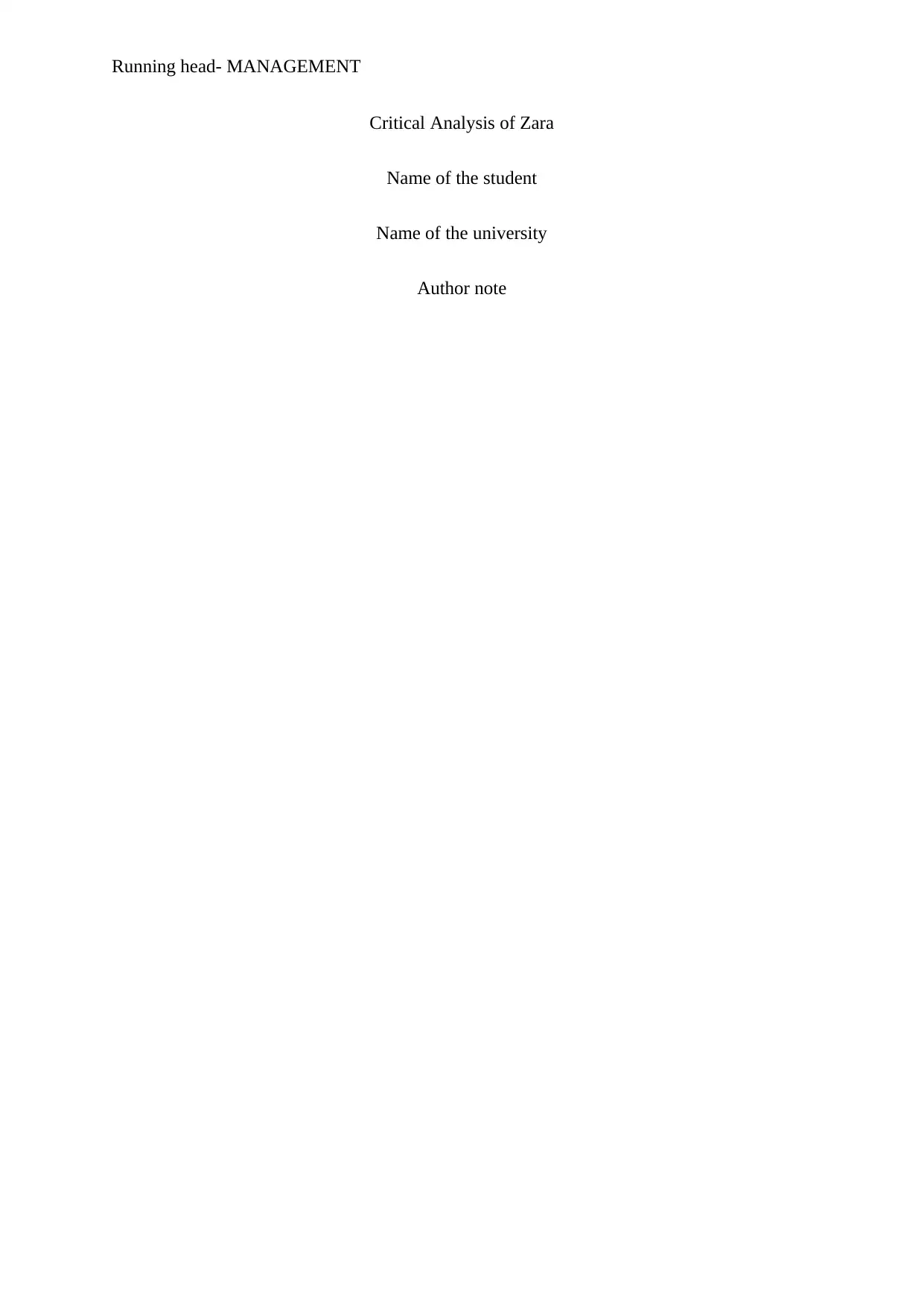
Running head- MANAGEMENT
Critical Analysis of Zara
Name of the student
Name of the university
Author note
Critical Analysis of Zara
Name of the student
Name of the university
Author note
Secure Best Marks with AI Grader
Need help grading? Try our AI Grader for instant feedback on your assignments.
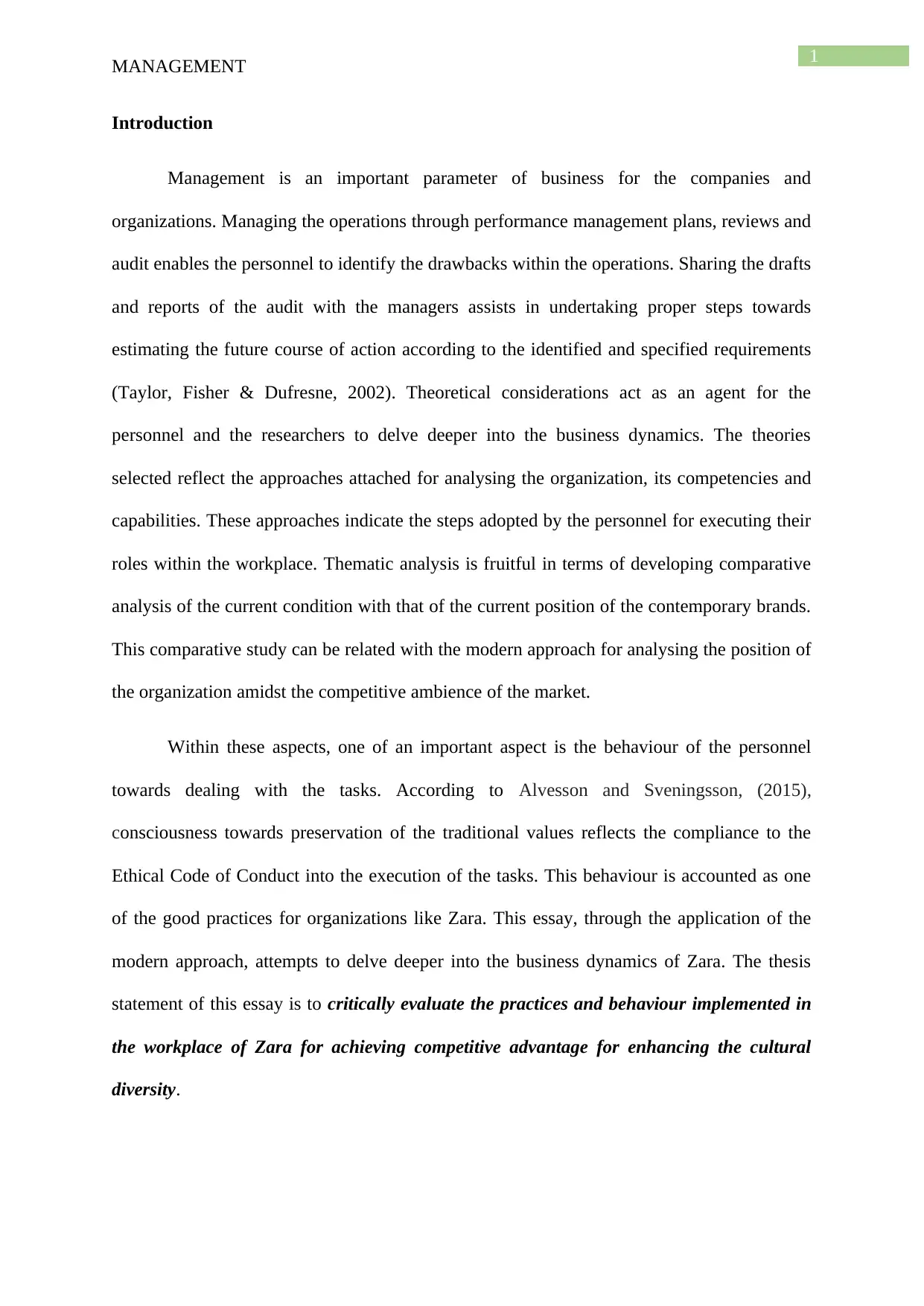
1
MANAGEMENT
Introduction
Management is an important parameter of business for the companies and
organizations. Managing the operations through performance management plans, reviews and
audit enables the personnel to identify the drawbacks within the operations. Sharing the drafts
and reports of the audit with the managers assists in undertaking proper steps towards
estimating the future course of action according to the identified and specified requirements
(Taylor, Fisher & Dufresne, 2002). Theoretical considerations act as an agent for the
personnel and the researchers to delve deeper into the business dynamics. The theories
selected reflect the approaches attached for analysing the organization, its competencies and
capabilities. These approaches indicate the steps adopted by the personnel for executing their
roles within the workplace. Thematic analysis is fruitful in terms of developing comparative
analysis of the current condition with that of the current position of the contemporary brands.
This comparative study can be related with the modern approach for analysing the position of
the organization amidst the competitive ambience of the market.
Within these aspects, one of an important aspect is the behaviour of the personnel
towards dealing with the tasks. According to Alvesson and Sveningsson, (2015),
consciousness towards preservation of the traditional values reflects the compliance to the
Ethical Code of Conduct into the execution of the tasks. This behaviour is accounted as one
of the good practices for organizations like Zara. This essay, through the application of the
modern approach, attempts to delve deeper into the business dynamics of Zara. The thesis
statement of this essay is to critically evaluate the practices and behaviour implemented in
the workplace of Zara for achieving competitive advantage for enhancing the cultural
diversity.
MANAGEMENT
Introduction
Management is an important parameter of business for the companies and
organizations. Managing the operations through performance management plans, reviews and
audit enables the personnel to identify the drawbacks within the operations. Sharing the drafts
and reports of the audit with the managers assists in undertaking proper steps towards
estimating the future course of action according to the identified and specified requirements
(Taylor, Fisher & Dufresne, 2002). Theoretical considerations act as an agent for the
personnel and the researchers to delve deeper into the business dynamics. The theories
selected reflect the approaches attached for analysing the organization, its competencies and
capabilities. These approaches indicate the steps adopted by the personnel for executing their
roles within the workplace. Thematic analysis is fruitful in terms of developing comparative
analysis of the current condition with that of the current position of the contemporary brands.
This comparative study can be related with the modern approach for analysing the position of
the organization amidst the competitive ambience of the market.
Within these aspects, one of an important aspect is the behaviour of the personnel
towards dealing with the tasks. According to Alvesson and Sveningsson, (2015),
consciousness towards preservation of the traditional values reflects the compliance to the
Ethical Code of Conduct into the execution of the tasks. This behaviour is accounted as one
of the good practices for organizations like Zara. This essay, through the application of the
modern approach, attempts to delve deeper into the business dynamics of Zara. The thesis
statement of this essay is to critically evaluate the practices and behaviour implemented in
the workplace of Zara for achieving competitive advantage for enhancing the cultural
diversity.
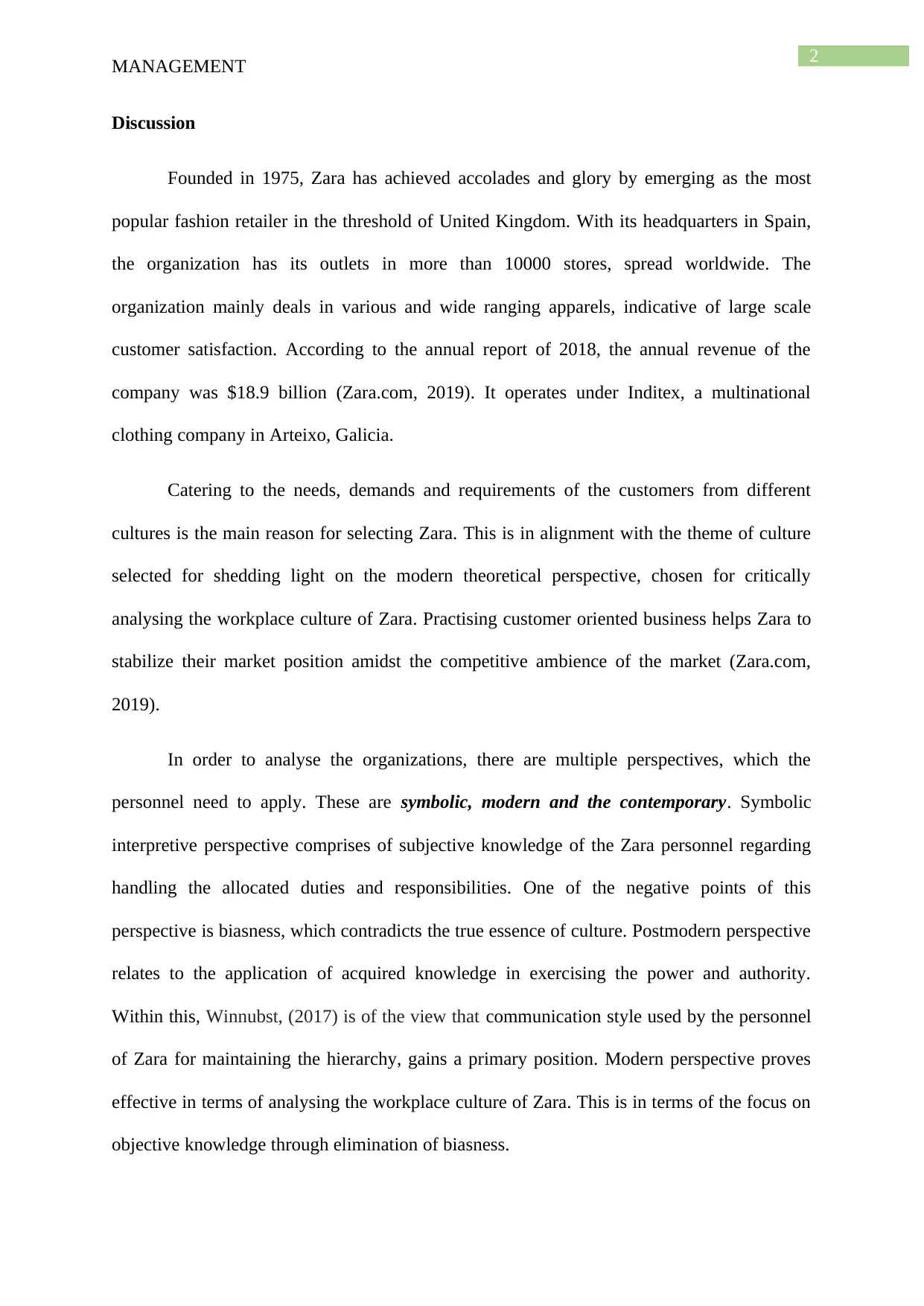
2
MANAGEMENT
Discussion
Founded in 1975, Zara has achieved accolades and glory by emerging as the most
popular fashion retailer in the threshold of United Kingdom. With its headquarters in Spain,
the organization has its outlets in more than 10000 stores, spread worldwide. The
organization mainly deals in various and wide ranging apparels, indicative of large scale
customer satisfaction. According to the annual report of 2018, the annual revenue of the
company was $18.9 billion (Zara.com, 2019). It operates under Inditex, a multinational
clothing company in Arteixo, Galicia.
Catering to the needs, demands and requirements of the customers from different
cultures is the main reason for selecting Zara. This is in alignment with the theme of culture
selected for shedding light on the modern theoretical perspective, chosen for critically
analysing the workplace culture of Zara. Practising customer oriented business helps Zara to
stabilize their market position amidst the competitive ambience of the market (Zara.com,
2019).
In order to analyse the organizations, there are multiple perspectives, which the
personnel need to apply. These are symbolic, modern and the contemporary. Symbolic
interpretive perspective comprises of subjective knowledge of the Zara personnel regarding
handling the allocated duties and responsibilities. One of the negative points of this
perspective is biasness, which contradicts the true essence of culture. Postmodern perspective
relates to the application of acquired knowledge in exercising the power and authority.
Within this, Winnubst, (2017) is of the view that communication style used by the personnel
of Zara for maintaining the hierarchy, gains a primary position. Modern perspective proves
effective in terms of analysing the workplace culture of Zara. This is in terms of the focus on
objective knowledge through elimination of biasness.
MANAGEMENT
Discussion
Founded in 1975, Zara has achieved accolades and glory by emerging as the most
popular fashion retailer in the threshold of United Kingdom. With its headquarters in Spain,
the organization has its outlets in more than 10000 stores, spread worldwide. The
organization mainly deals in various and wide ranging apparels, indicative of large scale
customer satisfaction. According to the annual report of 2018, the annual revenue of the
company was $18.9 billion (Zara.com, 2019). It operates under Inditex, a multinational
clothing company in Arteixo, Galicia.
Catering to the needs, demands and requirements of the customers from different
cultures is the main reason for selecting Zara. This is in alignment with the theme of culture
selected for shedding light on the modern theoretical perspective, chosen for critically
analysing the workplace culture of Zara. Practising customer oriented business helps Zara to
stabilize their market position amidst the competitive ambience of the market (Zara.com,
2019).
In order to analyse the organizations, there are multiple perspectives, which the
personnel need to apply. These are symbolic, modern and the contemporary. Symbolic
interpretive perspective comprises of subjective knowledge of the Zara personnel regarding
handling the allocated duties and responsibilities. One of the negative points of this
perspective is biasness, which contradicts the true essence of culture. Postmodern perspective
relates to the application of acquired knowledge in exercising the power and authority.
Within this, Winnubst, (2017) is of the view that communication style used by the personnel
of Zara for maintaining the hierarchy, gains a primary position. Modern perspective proves
effective in terms of analysing the workplace culture of Zara. This is in terms of the focus on
objective knowledge through elimination of biasness.
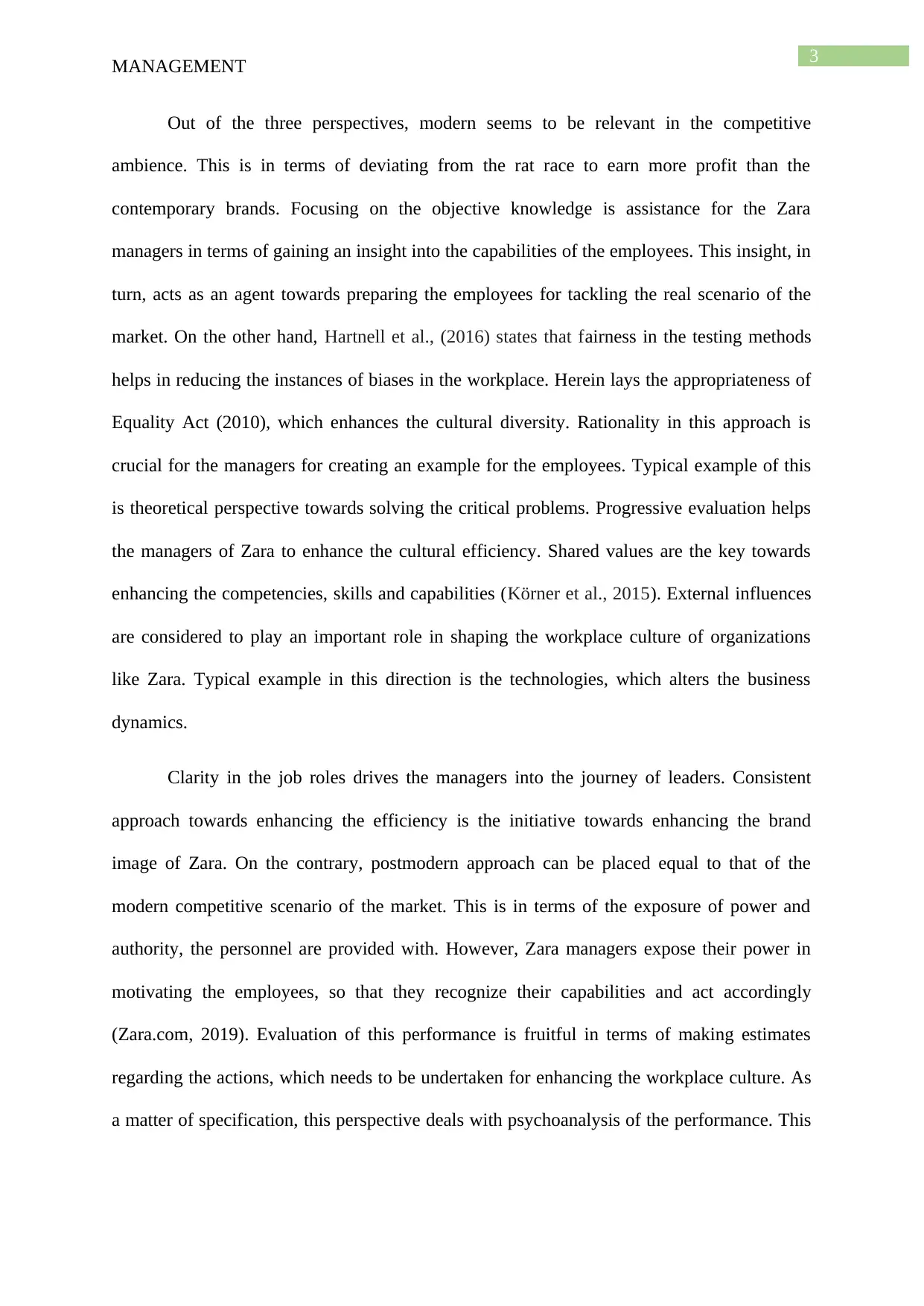
3
MANAGEMENT
Out of the three perspectives, modern seems to be relevant in the competitive
ambience. This is in terms of deviating from the rat race to earn more profit than the
contemporary brands. Focusing on the objective knowledge is assistance for the Zara
managers in terms of gaining an insight into the capabilities of the employees. This insight, in
turn, acts as an agent towards preparing the employees for tackling the real scenario of the
market. On the other hand, Hartnell et al., (2016) states that fairness in the testing methods
helps in reducing the instances of biases in the workplace. Herein lays the appropriateness of
Equality Act (2010), which enhances the cultural diversity. Rationality in this approach is
crucial for the managers for creating an example for the employees. Typical example of this
is theoretical perspective towards solving the critical problems. Progressive evaluation helps
the managers of Zara to enhance the cultural efficiency. Shared values are the key towards
enhancing the competencies, skills and capabilities (Körner et al., 2015). External influences
are considered to play an important role in shaping the workplace culture of organizations
like Zara. Typical example in this direction is the technologies, which alters the business
dynamics.
Clarity in the job roles drives the managers into the journey of leaders. Consistent
approach towards enhancing the efficiency is the initiative towards enhancing the brand
image of Zara. On the contrary, postmodern approach can be placed equal to that of the
modern competitive scenario of the market. This is in terms of the exposure of power and
authority, the personnel are provided with. However, Zara managers expose their power in
motivating the employees, so that they recognize their capabilities and act accordingly
(Zara.com, 2019). Evaluation of this performance is fruitful in terms of making estimates
regarding the actions, which needs to be undertaken for enhancing the workplace culture. As
a matter of specification, this perspective deals with psychoanalysis of the performance. This
MANAGEMENT
Out of the three perspectives, modern seems to be relevant in the competitive
ambience. This is in terms of deviating from the rat race to earn more profit than the
contemporary brands. Focusing on the objective knowledge is assistance for the Zara
managers in terms of gaining an insight into the capabilities of the employees. This insight, in
turn, acts as an agent towards preparing the employees for tackling the real scenario of the
market. On the other hand, Hartnell et al., (2016) states that fairness in the testing methods
helps in reducing the instances of biases in the workplace. Herein lays the appropriateness of
Equality Act (2010), which enhances the cultural diversity. Rationality in this approach is
crucial for the managers for creating an example for the employees. Typical example of this
is theoretical perspective towards solving the critical problems. Progressive evaluation helps
the managers of Zara to enhance the cultural efficiency. Shared values are the key towards
enhancing the competencies, skills and capabilities (Körner et al., 2015). External influences
are considered to play an important role in shaping the workplace culture of organizations
like Zara. Typical example in this direction is the technologies, which alters the business
dynamics.
Clarity in the job roles drives the managers into the journey of leaders. Consistent
approach towards enhancing the efficiency is the initiative towards enhancing the brand
image of Zara. On the contrary, postmodern approach can be placed equal to that of the
modern competitive scenario of the market. This is in terms of the exposure of power and
authority, the personnel are provided with. However, Zara managers expose their power in
motivating the employees, so that they recognize their capabilities and act accordingly
(Zara.com, 2019). Evaluation of this performance is fruitful in terms of making estimates
regarding the actions, which needs to be undertaken for enhancing the workplace culture. As
a matter of specification, this perspective deals with psychoanalysis of the performance. This
Secure Best Marks with AI Grader
Need help grading? Try our AI Grader for instant feedback on your assignments.
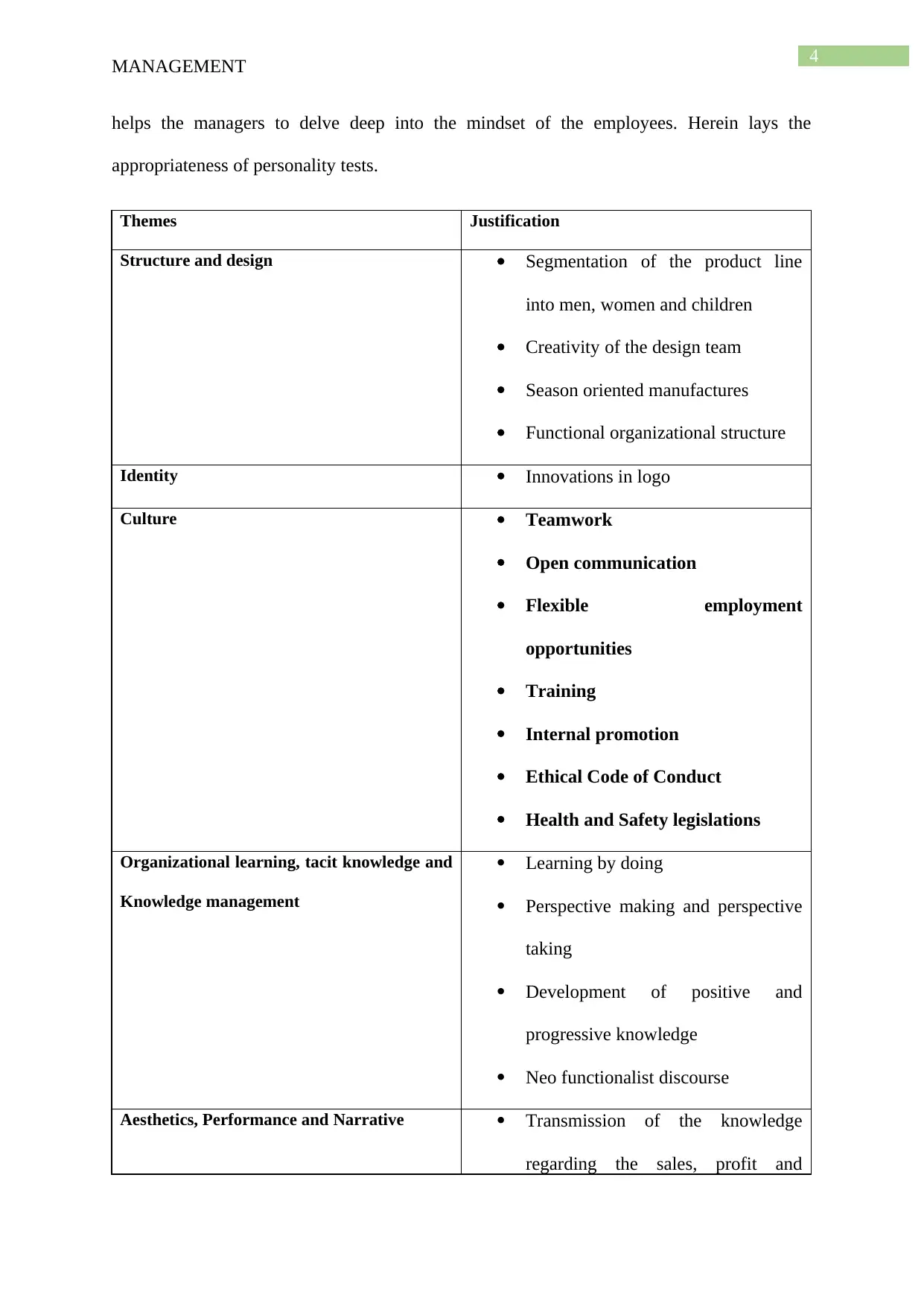
4
MANAGEMENT
helps the managers to delve deep into the mindset of the employees. Herein lays the
appropriateness of personality tests.
Themes Justification
Structure and design Segmentation of the product line
into men, women and children
Creativity of the design team
Season oriented manufactures
Functional organizational structure
Identity Innovations in logo
Culture Teamwork
Open communication
Flexible employment
opportunities
Training
Internal promotion
Ethical Code of Conduct
Health and Safety legislations
Organizational learning, tacit knowledge and
Knowledge management
Learning by doing
Perspective making and perspective
taking
Development of positive and
progressive knowledge
Neo functionalist discourse
Aesthetics, Performance and Narrative Transmission of the knowledge
regarding the sales, profit and
MANAGEMENT
helps the managers to delve deep into the mindset of the employees. Herein lays the
appropriateness of personality tests.
Themes Justification
Structure and design Segmentation of the product line
into men, women and children
Creativity of the design team
Season oriented manufactures
Functional organizational structure
Identity Innovations in logo
Culture Teamwork
Open communication
Flexible employment
opportunities
Training
Internal promotion
Ethical Code of Conduct
Health and Safety legislations
Organizational learning, tacit knowledge and
Knowledge management
Learning by doing
Perspective making and perspective
taking
Development of positive and
progressive knowledge
Neo functionalist discourse
Aesthetics, Performance and Narrative Transmission of the knowledge
regarding the sales, profit and

5
MANAGEMENT
productivity from the managers to
the employees
Power and Control Managers
Policies
Ethical code of conduct
Genderr Male and female workers
Relevance of the seven themes to Zara
Table 1- Thematic analysis of Zara
(Source- Zara.com, 2019)
Functional organizational structure is assistance for Zara in terms of catering to the
needs, demands and requirements of the clients and the customers. The departmental units
collaborate for completing the projects within the stipulated time. Group discussions reduce
the intensity of conflicts, discriminations and harassments within the workplace. This group
work reduces knowledge gaps, enhancing the compatibility and adjustment skills. Sharing the
ideas of innovative logos is an attempt towards enhancing the brand image. Open
communication between the managers and the team members is assistance in terms of
enhancing the cultural diversity.
Implementation of Ethical Code of Conduct in the business strategies avert any kind
of unethical or misconduct (Zara.com, 2019). Strictness in this direction makes Zara one of
the preferred choices among the clients and the customers in terms of culture. Cultural
training is provided to the employees of Zara so that they learn about the ethical behaviour,
which they need to expose for enhancing their personality. Flexibility in the employment
opportunities along with health and safety are the components, which assures the employees,
that their interests are taken care. The managers of the opinion that employees learn fast when
MANAGEMENT
productivity from the managers to
the employees
Power and Control Managers
Policies
Ethical code of conduct
Genderr Male and female workers
Relevance of the seven themes to Zara
Table 1- Thematic analysis of Zara
(Source- Zara.com, 2019)
Functional organizational structure is assistance for Zara in terms of catering to the
needs, demands and requirements of the clients and the customers. The departmental units
collaborate for completing the projects within the stipulated time. Group discussions reduce
the intensity of conflicts, discriminations and harassments within the workplace. This group
work reduces knowledge gaps, enhancing the compatibility and adjustment skills. Sharing the
ideas of innovative logos is an attempt towards enhancing the brand image. Open
communication between the managers and the team members is assistance in terms of
enhancing the cultural diversity.
Implementation of Ethical Code of Conduct in the business strategies avert any kind
of unethical or misconduct (Zara.com, 2019). Strictness in this direction makes Zara one of
the preferred choices among the clients and the customers in terms of culture. Cultural
training is provided to the employees of Zara so that they learn about the ethical behaviour,
which they need to expose for enhancing their personality. Flexibility in the employment
opportunities along with health and safety are the components, which assures the employees,
that their interests are taken care. The managers of the opinion that employees learn fast when
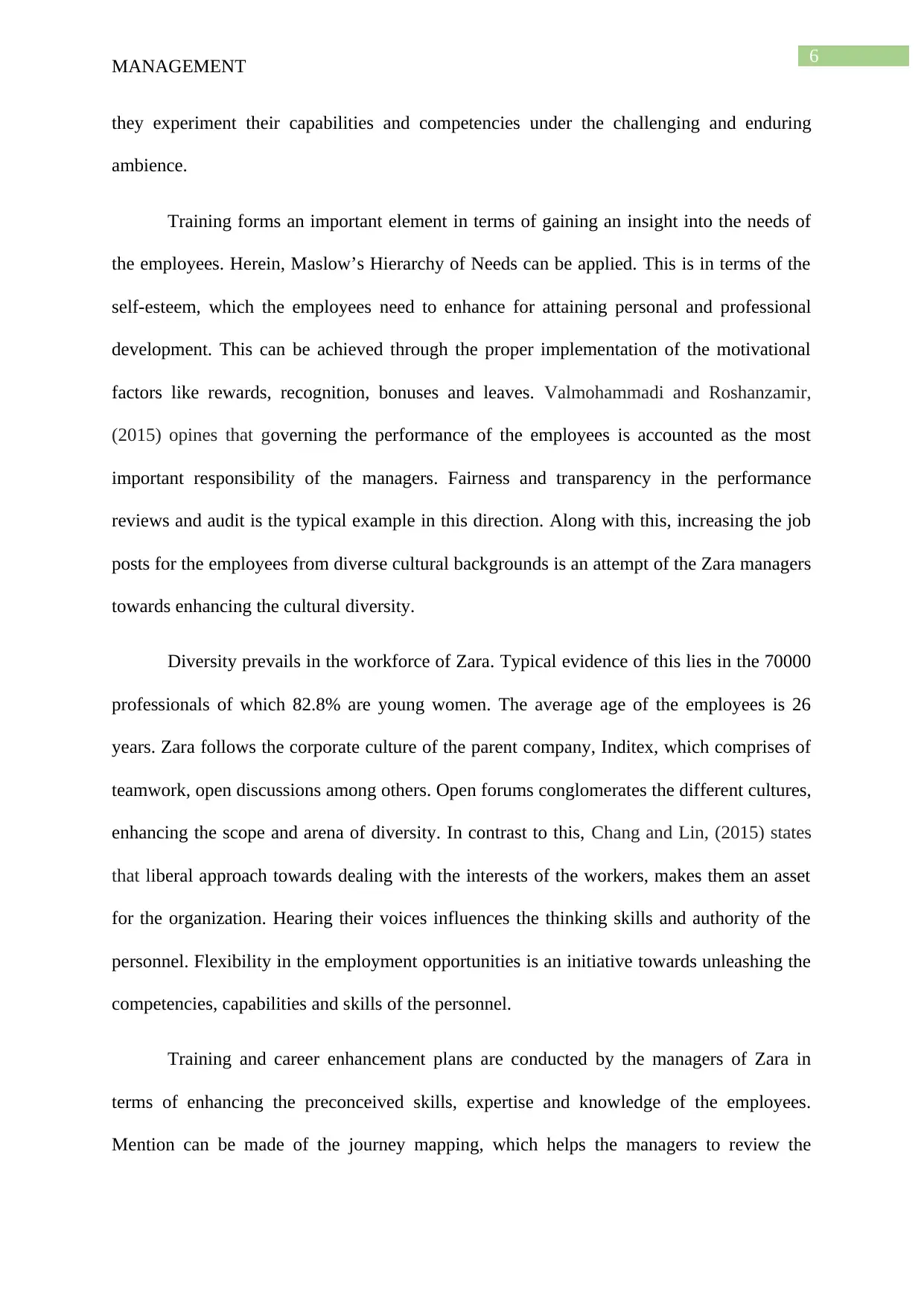
6
MANAGEMENT
they experiment their capabilities and competencies under the challenging and enduring
ambience.
Training forms an important element in terms of gaining an insight into the needs of
the employees. Herein, Maslow’s Hierarchy of Needs can be applied. This is in terms of the
self-esteem, which the employees need to enhance for attaining personal and professional
development. This can be achieved through the proper implementation of the motivational
factors like rewards, recognition, bonuses and leaves. Valmohammadi and Roshanzamir,
(2015) opines that governing the performance of the employees is accounted as the most
important responsibility of the managers. Fairness and transparency in the performance
reviews and audit is the typical example in this direction. Along with this, increasing the job
posts for the employees from diverse cultural backgrounds is an attempt of the Zara managers
towards enhancing the cultural diversity.
Diversity prevails in the workforce of Zara. Typical evidence of this lies in the 70000
professionals of which 82.8% are young women. The average age of the employees is 26
years. Zara follows the corporate culture of the parent company, Inditex, which comprises of
teamwork, open discussions among others. Open forums conglomerates the different cultures,
enhancing the scope and arena of diversity. In contrast to this, Chang and Lin, (2015) states
that liberal approach towards dealing with the interests of the workers, makes them an asset
for the organization. Hearing their voices influences the thinking skills and authority of the
personnel. Flexibility in the employment opportunities is an initiative towards unleashing the
competencies, capabilities and skills of the personnel.
Training and career enhancement plans are conducted by the managers of Zara in
terms of enhancing the preconceived skills, expertise and knowledge of the employees.
Mention can be made of the journey mapping, which helps the managers to review the
MANAGEMENT
they experiment their capabilities and competencies under the challenging and enduring
ambience.
Training forms an important element in terms of gaining an insight into the needs of
the employees. Herein, Maslow’s Hierarchy of Needs can be applied. This is in terms of the
self-esteem, which the employees need to enhance for attaining personal and professional
development. This can be achieved through the proper implementation of the motivational
factors like rewards, recognition, bonuses and leaves. Valmohammadi and Roshanzamir,
(2015) opines that governing the performance of the employees is accounted as the most
important responsibility of the managers. Fairness and transparency in the performance
reviews and audit is the typical example in this direction. Along with this, increasing the job
posts for the employees from diverse cultural backgrounds is an attempt of the Zara managers
towards enhancing the cultural diversity.
Diversity prevails in the workforce of Zara. Typical evidence of this lies in the 70000
professionals of which 82.8% are young women. The average age of the employees is 26
years. Zara follows the corporate culture of the parent company, Inditex, which comprises of
teamwork, open discussions among others. Open forums conglomerates the different cultures,
enhancing the scope and arena of diversity. In contrast to this, Chang and Lin, (2015) states
that liberal approach towards dealing with the interests of the workers, makes them an asset
for the organization. Hearing their voices influences the thinking skills and authority of the
personnel. Flexibility in the employment opportunities is an initiative towards unleashing the
competencies, capabilities and skills of the personnel.
Training and career enhancement plans are conducted by the managers of Zara in
terms of enhancing the preconceived skills, expertise and knowledge of the employees.
Mention can be made of the journey mapping, which helps the managers to review the
Paraphrase This Document
Need a fresh take? Get an instant paraphrase of this document with our AI Paraphraser
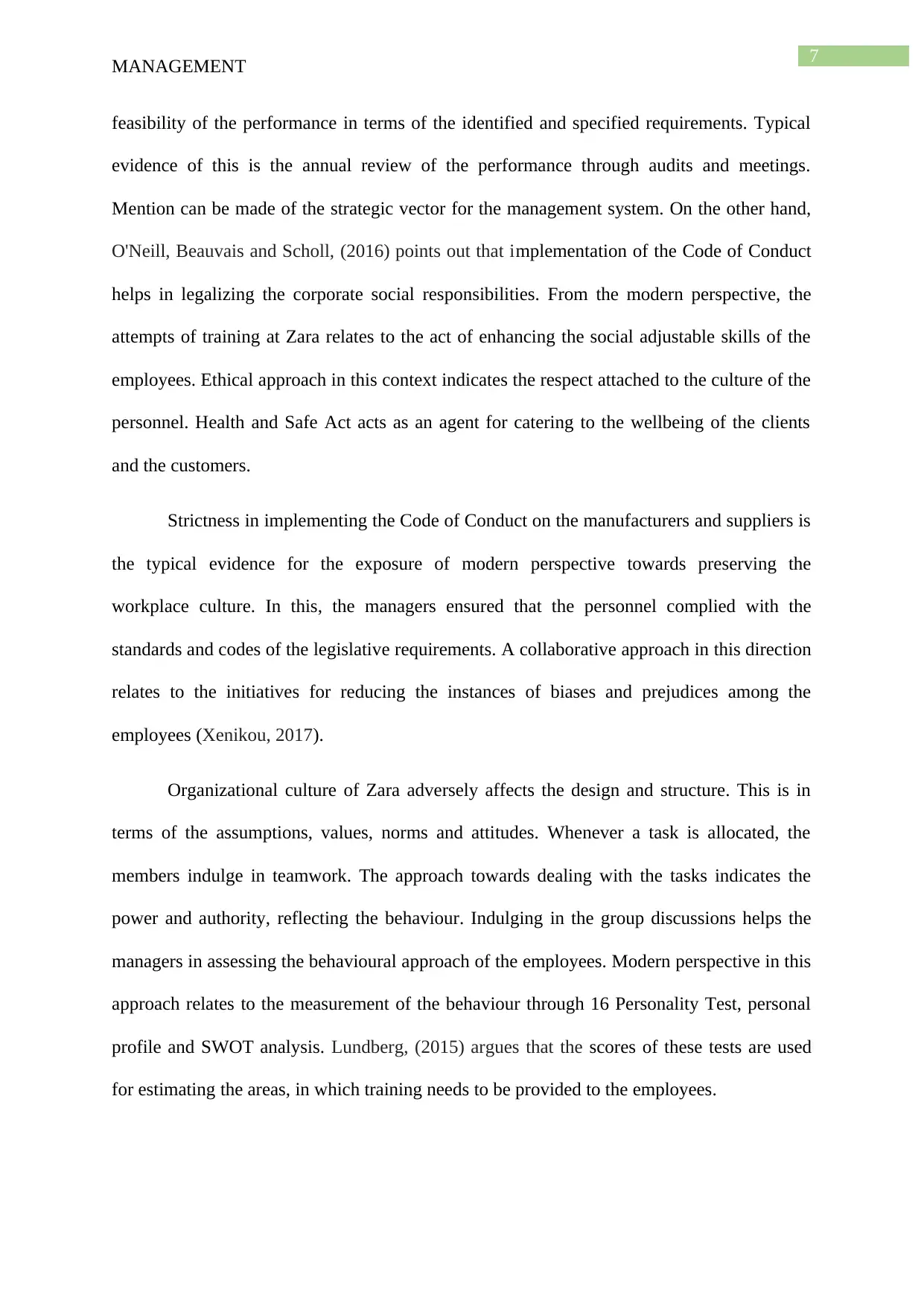
7
MANAGEMENT
feasibility of the performance in terms of the identified and specified requirements. Typical
evidence of this is the annual review of the performance through audits and meetings.
Mention can be made of the strategic vector for the management system. On the other hand,
O'Neill, Beauvais and Scholl, (2016) points out that implementation of the Code of Conduct
helps in legalizing the corporate social responsibilities. From the modern perspective, the
attempts of training at Zara relates to the act of enhancing the social adjustable skills of the
employees. Ethical approach in this context indicates the respect attached to the culture of the
personnel. Health and Safe Act acts as an agent for catering to the wellbeing of the clients
and the customers.
Strictness in implementing the Code of Conduct on the manufacturers and suppliers is
the typical evidence for the exposure of modern perspective towards preserving the
workplace culture. In this, the managers ensured that the personnel complied with the
standards and codes of the legislative requirements. A collaborative approach in this direction
relates to the initiatives for reducing the instances of biases and prejudices among the
employees (Xenikou, 2017).
Organizational culture of Zara adversely affects the design and structure. This is in
terms of the assumptions, values, norms and attitudes. Whenever a task is allocated, the
members indulge in teamwork. The approach towards dealing with the tasks indicates the
power and authority, reflecting the behaviour. Indulging in the group discussions helps the
managers in assessing the behavioural approach of the employees. Modern perspective in this
approach relates to the measurement of the behaviour through 16 Personality Test, personal
profile and SWOT analysis. Lundberg, (2015) argues that the scores of these tests are used
for estimating the areas, in which training needs to be provided to the employees.
MANAGEMENT
feasibility of the performance in terms of the identified and specified requirements. Typical
evidence of this is the annual review of the performance through audits and meetings.
Mention can be made of the strategic vector for the management system. On the other hand,
O'Neill, Beauvais and Scholl, (2016) points out that implementation of the Code of Conduct
helps in legalizing the corporate social responsibilities. From the modern perspective, the
attempts of training at Zara relates to the act of enhancing the social adjustable skills of the
employees. Ethical approach in this context indicates the respect attached to the culture of the
personnel. Health and Safe Act acts as an agent for catering to the wellbeing of the clients
and the customers.
Strictness in implementing the Code of Conduct on the manufacturers and suppliers is
the typical evidence for the exposure of modern perspective towards preserving the
workplace culture. In this, the managers ensured that the personnel complied with the
standards and codes of the legislative requirements. A collaborative approach in this direction
relates to the initiatives for reducing the instances of biases and prejudices among the
employees (Xenikou, 2017).
Organizational culture of Zara adversely affects the design and structure. This is in
terms of the assumptions, values, norms and attitudes. Whenever a task is allocated, the
members indulge in teamwork. The approach towards dealing with the tasks indicates the
power and authority, reflecting the behaviour. Indulging in the group discussions helps the
managers in assessing the behavioural approach of the employees. Modern perspective in this
approach relates to the measurement of the behaviour through 16 Personality Test, personal
profile and SWOT analysis. Lundberg, (2015) argues that the scores of these tests are used
for estimating the areas, in which training needs to be provided to the employees.
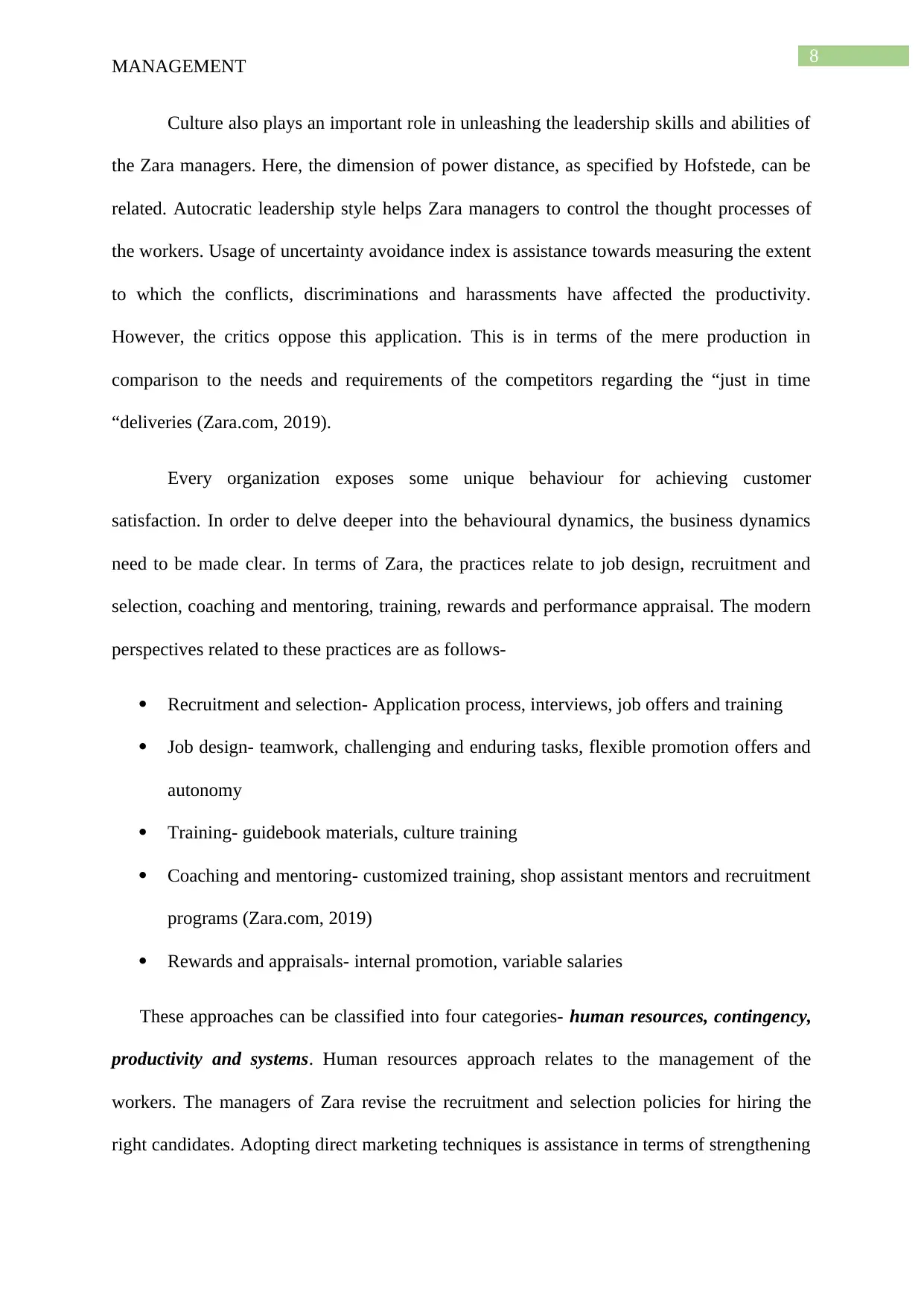
8
MANAGEMENT
Culture also plays an important role in unleashing the leadership skills and abilities of
the Zara managers. Here, the dimension of power distance, as specified by Hofstede, can be
related. Autocratic leadership style helps Zara managers to control the thought processes of
the workers. Usage of uncertainty avoidance index is assistance towards measuring the extent
to which the conflicts, discriminations and harassments have affected the productivity.
However, the critics oppose this application. This is in terms of the mere production in
comparison to the needs and requirements of the competitors regarding the “just in time
“deliveries (Zara.com, 2019).
Every organization exposes some unique behaviour for achieving customer
satisfaction. In order to delve deeper into the behavioural dynamics, the business dynamics
need to be made clear. In terms of Zara, the practices relate to job design, recruitment and
selection, coaching and mentoring, training, rewards and performance appraisal. The modern
perspectives related to these practices are as follows-
Recruitment and selection- Application process, interviews, job offers and training
Job design- teamwork, challenging and enduring tasks, flexible promotion offers and
autonomy
Training- guidebook materials, culture training
Coaching and mentoring- customized training, shop assistant mentors and recruitment
programs (Zara.com, 2019)
Rewards and appraisals- internal promotion, variable salaries
These approaches can be classified into four categories- human resources, contingency,
productivity and systems. Human resources approach relates to the management of the
workers. The managers of Zara revise the recruitment and selection policies for hiring the
right candidates. Adopting direct marketing techniques is assistance in terms of strengthening
MANAGEMENT
Culture also plays an important role in unleashing the leadership skills and abilities of
the Zara managers. Here, the dimension of power distance, as specified by Hofstede, can be
related. Autocratic leadership style helps Zara managers to control the thought processes of
the workers. Usage of uncertainty avoidance index is assistance towards measuring the extent
to which the conflicts, discriminations and harassments have affected the productivity.
However, the critics oppose this application. This is in terms of the mere production in
comparison to the needs and requirements of the competitors regarding the “just in time
“deliveries (Zara.com, 2019).
Every organization exposes some unique behaviour for achieving customer
satisfaction. In order to delve deeper into the behavioural dynamics, the business dynamics
need to be made clear. In terms of Zara, the practices relate to job design, recruitment and
selection, coaching and mentoring, training, rewards and performance appraisal. The modern
perspectives related to these practices are as follows-
Recruitment and selection- Application process, interviews, job offers and training
Job design- teamwork, challenging and enduring tasks, flexible promotion offers and
autonomy
Training- guidebook materials, culture training
Coaching and mentoring- customized training, shop assistant mentors and recruitment
programs (Zara.com, 2019)
Rewards and appraisals- internal promotion, variable salaries
These approaches can be classified into four categories- human resources, contingency,
productivity and systems. Human resources approach relates to the management of the
workers. The managers of Zara revise the recruitment and selection policies for hiring the
right candidates. Adopting direct marketing techniques is assistance in terms of strengthening

9
MANAGEMENT
the customer base. Typical example of this is the social media, where the application forms
are uploaded. The HR manager is entrusted with the responsibility to ensure that the
employees are receiving proper training from the supervisors. Offering lucrative promotion
offers is a means for ensuring proper growth and development of the skills, abilities and
competencies of the employees. Typical evidence of this is the performance appraisals, which
allows the managers to evaluate the readiness of the employees for venturing into the next
level of their performance (Zara.com, 2019).
Contingency approach indicates that different situations need different behavioural
approach. In the application of differing approaches, the personnel of Zara encounter various
variables, leading them to the appropriate solutions for enhancing the productivity. Adopting
this approach is assistance for Zara managers in terms of gaining an insight into thinking
skills and judgement of the employees. This assessment reflects the application of the gained
knowledge for executing the allocated duties and responsibilities.
Chatman and O’Reilly, (2016) are of the opinion that productivity approach relates to the
comparison between the input and the output. This is executed through the consideration of
charts, tables and graphs. Adequate opportunities are provided to the clients and the
customers regarding making their voices heard in the meetings. Capability and need analysis
is emphasized for the enhancing the sales productivity of Zara. None of the workers are
forced to work overtime, which reflects adherence to the protocols of Working Ombudsman.
Frequent inspections are conducted by the statutory bodies of law, which helps in reducing
the instances of illegal practices.
Systems approach sheds light on the interaction between the human and technological
resources. Within this, Cao et al., (2015) points out that the modern perspectives are
implementation of Data Protection Act (1998), Computer Misuse Act among others. These
MANAGEMENT
the customer base. Typical example of this is the social media, where the application forms
are uploaded. The HR manager is entrusted with the responsibility to ensure that the
employees are receiving proper training from the supervisors. Offering lucrative promotion
offers is a means for ensuring proper growth and development of the skills, abilities and
competencies of the employees. Typical evidence of this is the performance appraisals, which
allows the managers to evaluate the readiness of the employees for venturing into the next
level of their performance (Zara.com, 2019).
Contingency approach indicates that different situations need different behavioural
approach. In the application of differing approaches, the personnel of Zara encounter various
variables, leading them to the appropriate solutions for enhancing the productivity. Adopting
this approach is assistance for Zara managers in terms of gaining an insight into thinking
skills and judgement of the employees. This assessment reflects the application of the gained
knowledge for executing the allocated duties and responsibilities.
Chatman and O’Reilly, (2016) are of the opinion that productivity approach relates to the
comparison between the input and the output. This is executed through the consideration of
charts, tables and graphs. Adequate opportunities are provided to the clients and the
customers regarding making their voices heard in the meetings. Capability and need analysis
is emphasized for the enhancing the sales productivity of Zara. None of the workers are
forced to work overtime, which reflects adherence to the protocols of Working Ombudsman.
Frequent inspections are conducted by the statutory bodies of law, which helps in reducing
the instances of illegal practices.
Systems approach sheds light on the interaction between the human and technological
resources. Within this, Cao et al., (2015) points out that the modern perspectives are
implementation of Data Protection Act (1998), Computer Misuse Act among others. These
Secure Best Marks with AI Grader
Need help grading? Try our AI Grader for instant feedback on your assignments.
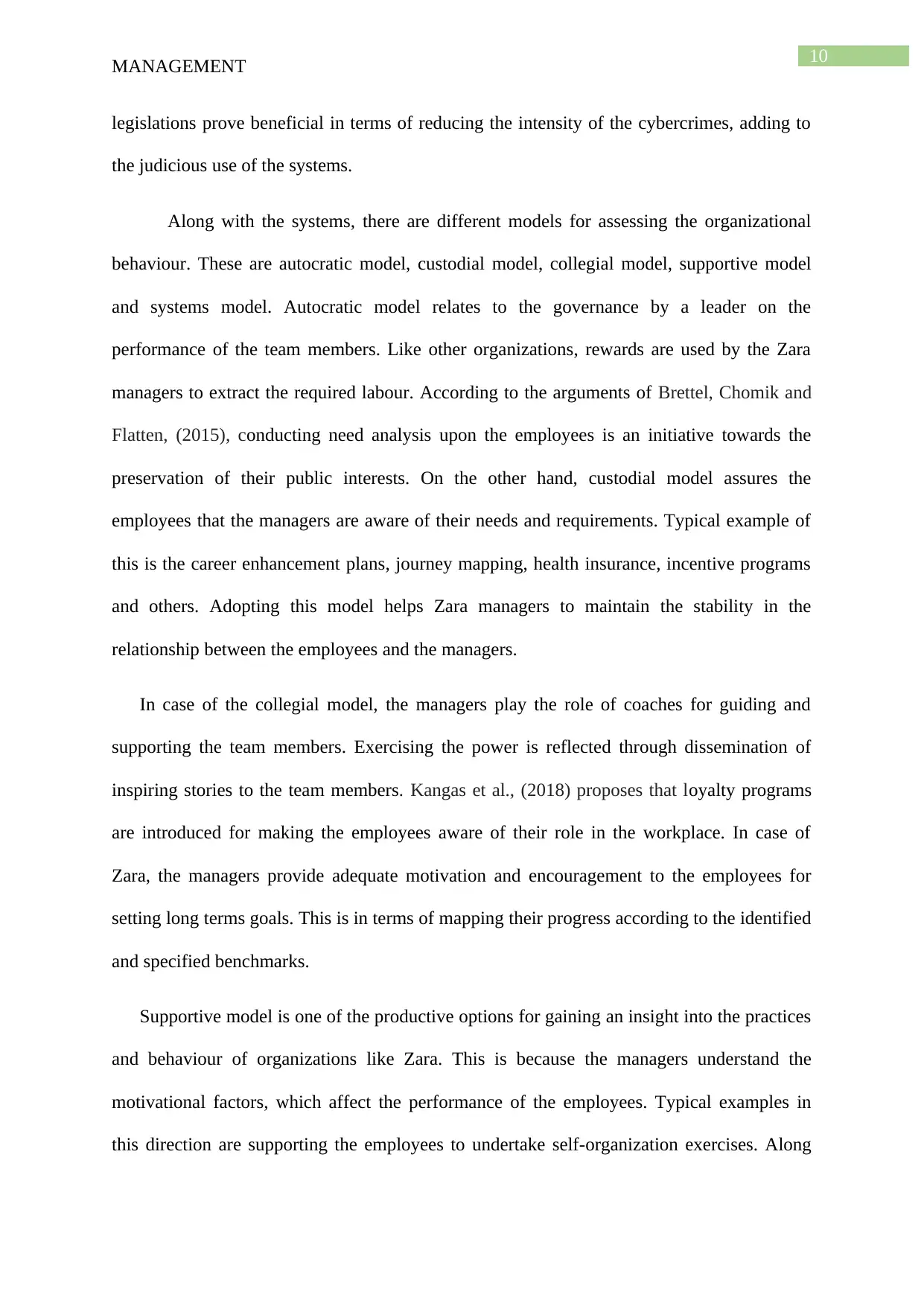
10
MANAGEMENT
legislations prove beneficial in terms of reducing the intensity of the cybercrimes, adding to
the judicious use of the systems.
Along with the systems, there are different models for assessing the organizational
behaviour. These are autocratic model, custodial model, collegial model, supportive model
and systems model. Autocratic model relates to the governance by a leader on the
performance of the team members. Like other organizations, rewards are used by the Zara
managers to extract the required labour. According to the arguments of Brettel, Chomik and
Flatten, (2015), conducting need analysis upon the employees is an initiative towards the
preservation of their public interests. On the other hand, custodial model assures the
employees that the managers are aware of their needs and requirements. Typical example of
this is the career enhancement plans, journey mapping, health insurance, incentive programs
and others. Adopting this model helps Zara managers to maintain the stability in the
relationship between the employees and the managers.
In case of the collegial model, the managers play the role of coaches for guiding and
supporting the team members. Exercising the power is reflected through dissemination of
inspiring stories to the team members. Kangas et al., (2018) proposes that loyalty programs
are introduced for making the employees aware of their role in the workplace. In case of
Zara, the managers provide adequate motivation and encouragement to the employees for
setting long terms goals. This is in terms of mapping their progress according to the identified
and specified benchmarks.
Supportive model is one of the productive options for gaining an insight into the practices
and behaviour of organizations like Zara. This is because the managers understand the
motivational factors, which affect the performance of the employees. Typical examples in
this direction are supporting the employees to undertake self-organization exercises. Along
MANAGEMENT
legislations prove beneficial in terms of reducing the intensity of the cybercrimes, adding to
the judicious use of the systems.
Along with the systems, there are different models for assessing the organizational
behaviour. These are autocratic model, custodial model, collegial model, supportive model
and systems model. Autocratic model relates to the governance by a leader on the
performance of the team members. Like other organizations, rewards are used by the Zara
managers to extract the required labour. According to the arguments of Brettel, Chomik and
Flatten, (2015), conducting need analysis upon the employees is an initiative towards the
preservation of their public interests. On the other hand, custodial model assures the
employees that the managers are aware of their needs and requirements. Typical example of
this is the career enhancement plans, journey mapping, health insurance, incentive programs
and others. Adopting this model helps Zara managers to maintain the stability in the
relationship between the employees and the managers.
In case of the collegial model, the managers play the role of coaches for guiding and
supporting the team members. Exercising the power is reflected through dissemination of
inspiring stories to the team members. Kangas et al., (2018) proposes that loyalty programs
are introduced for making the employees aware of their role in the workplace. In case of
Zara, the managers provide adequate motivation and encouragement to the employees for
setting long terms goals. This is in terms of mapping their progress according to the identified
and specified benchmarks.
Supportive model is one of the productive options for gaining an insight into the practices
and behaviour of organizations like Zara. This is because the managers understand the
motivational factors, which affect the performance of the employees. Typical examples in
this direction are supporting the employees to undertake self-organization exercises. Along
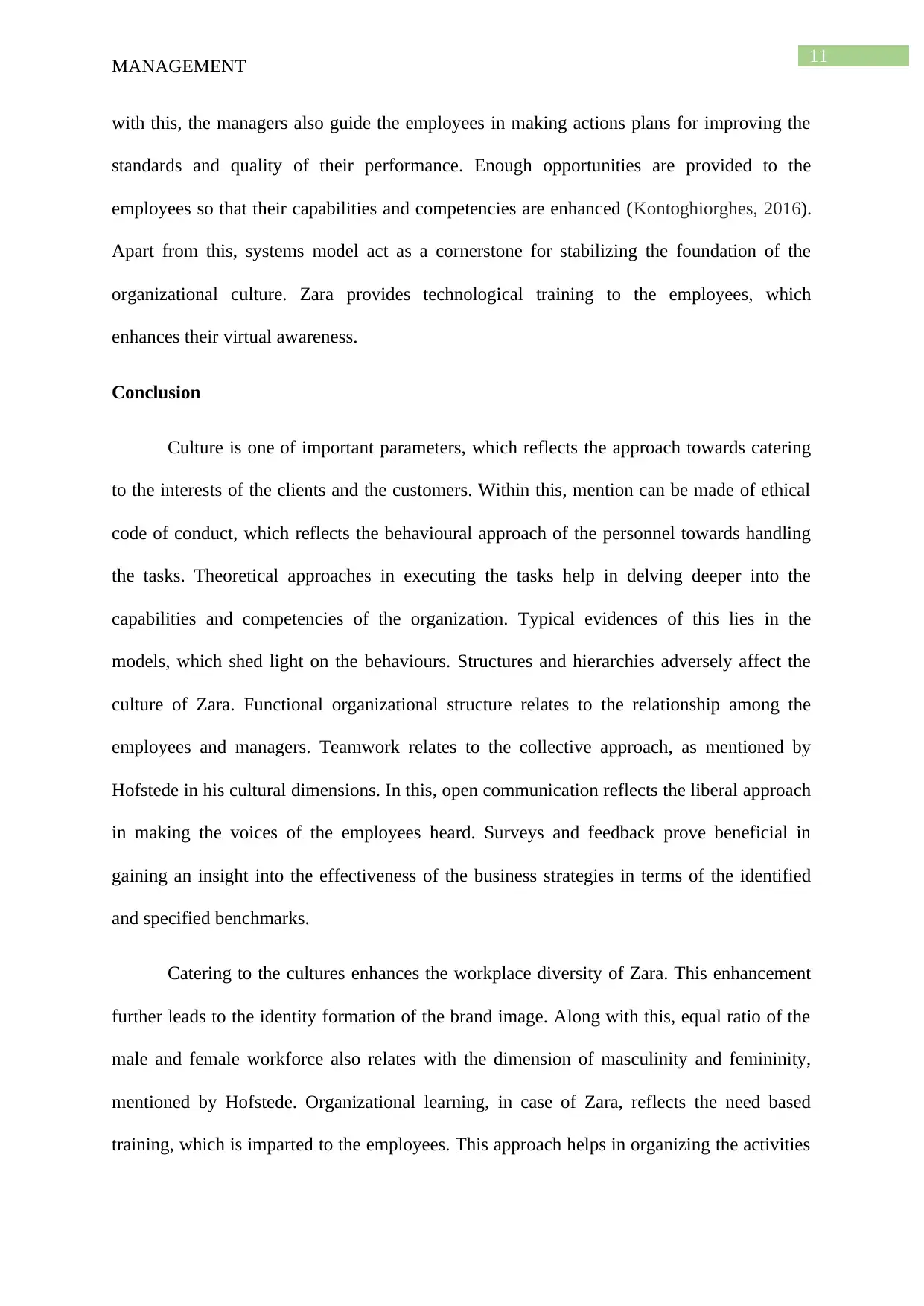
11
MANAGEMENT
with this, the managers also guide the employees in making actions plans for improving the
standards and quality of their performance. Enough opportunities are provided to the
employees so that their capabilities and competencies are enhanced (Kontoghiorghes, 2016).
Apart from this, systems model act as a cornerstone for stabilizing the foundation of the
organizational culture. Zara provides technological training to the employees, which
enhances their virtual awareness.
Conclusion
Culture is one of important parameters, which reflects the approach towards catering
to the interests of the clients and the customers. Within this, mention can be made of ethical
code of conduct, which reflects the behavioural approach of the personnel towards handling
the tasks. Theoretical approaches in executing the tasks help in delving deeper into the
capabilities and competencies of the organization. Typical evidences of this lies in the
models, which shed light on the behaviours. Structures and hierarchies adversely affect the
culture of Zara. Functional organizational structure relates to the relationship among the
employees and managers. Teamwork relates to the collective approach, as mentioned by
Hofstede in his cultural dimensions. In this, open communication reflects the liberal approach
in making the voices of the employees heard. Surveys and feedback prove beneficial in
gaining an insight into the effectiveness of the business strategies in terms of the identified
and specified benchmarks.
Catering to the cultures enhances the workplace diversity of Zara. This enhancement
further leads to the identity formation of the brand image. Along with this, equal ratio of the
male and female workforce also relates with the dimension of masculinity and femininity,
mentioned by Hofstede. Organizational learning, in case of Zara, reflects the need based
training, which is imparted to the employees. This approach helps in organizing the activities
MANAGEMENT
with this, the managers also guide the employees in making actions plans for improving the
standards and quality of their performance. Enough opportunities are provided to the
employees so that their capabilities and competencies are enhanced (Kontoghiorghes, 2016).
Apart from this, systems model act as a cornerstone for stabilizing the foundation of the
organizational culture. Zara provides technological training to the employees, which
enhances their virtual awareness.
Conclusion
Culture is one of important parameters, which reflects the approach towards catering
to the interests of the clients and the customers. Within this, mention can be made of ethical
code of conduct, which reflects the behavioural approach of the personnel towards handling
the tasks. Theoretical approaches in executing the tasks help in delving deeper into the
capabilities and competencies of the organization. Typical evidences of this lies in the
models, which shed light on the behaviours. Structures and hierarchies adversely affect the
culture of Zara. Functional organizational structure relates to the relationship among the
employees and managers. Teamwork relates to the collective approach, as mentioned by
Hofstede in his cultural dimensions. In this, open communication reflects the liberal approach
in making the voices of the employees heard. Surveys and feedback prove beneficial in
gaining an insight into the effectiveness of the business strategies in terms of the identified
and specified benchmarks.
Catering to the cultures enhances the workplace diversity of Zara. This enhancement
further leads to the identity formation of the brand image. Along with this, equal ratio of the
male and female workforce also relates with the dimension of masculinity and femininity,
mentioned by Hofstede. Organizational learning, in case of Zara, reflects the need based
training, which is imparted to the employees. This approach helps in organizing the activities
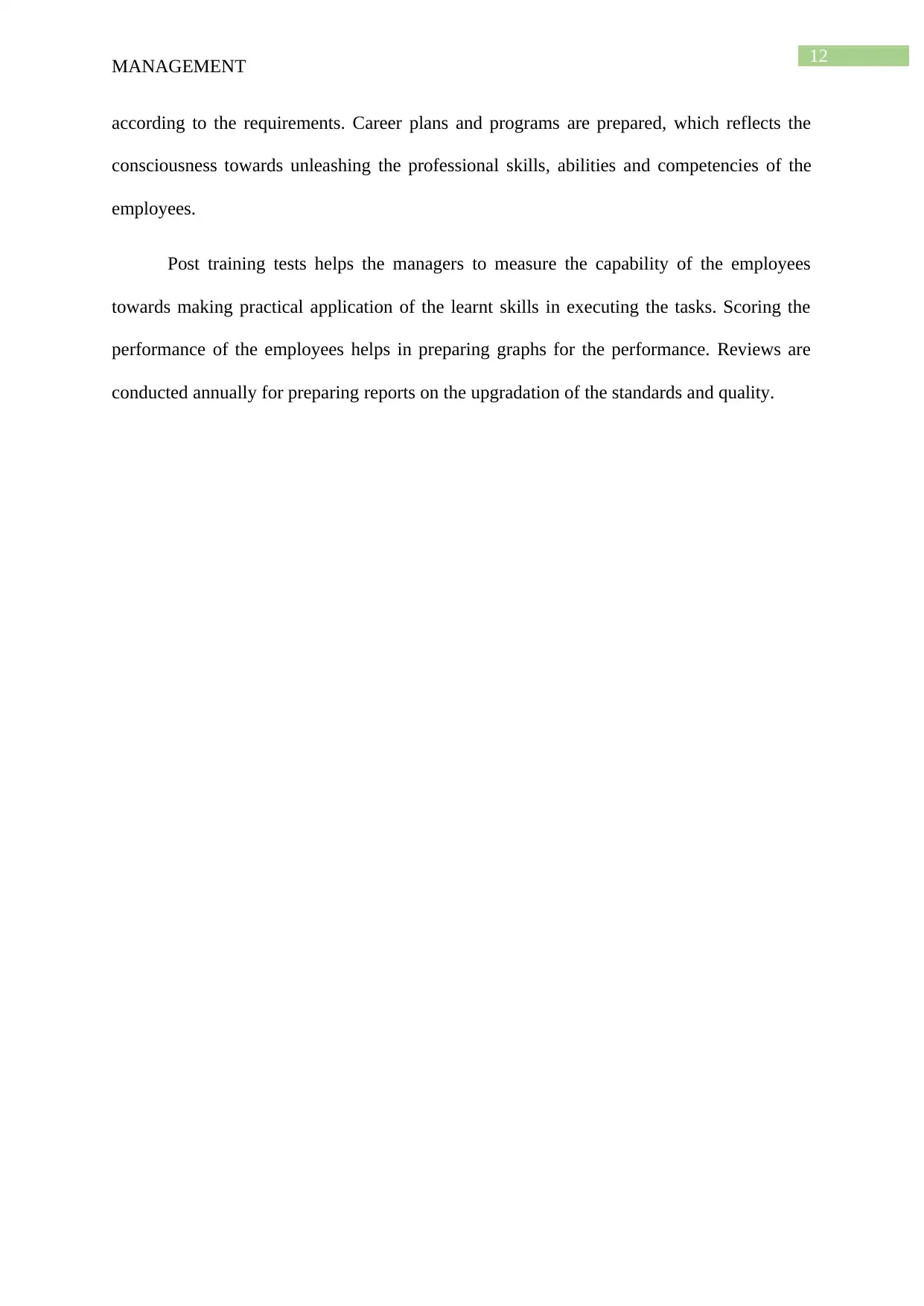
12
MANAGEMENT
according to the requirements. Career plans and programs are prepared, which reflects the
consciousness towards unleashing the professional skills, abilities and competencies of the
employees.
Post training tests helps the managers to measure the capability of the employees
towards making practical application of the learnt skills in executing the tasks. Scoring the
performance of the employees helps in preparing graphs for the performance. Reviews are
conducted annually for preparing reports on the upgradation of the standards and quality.
MANAGEMENT
according to the requirements. Career plans and programs are prepared, which reflects the
consciousness towards unleashing the professional skills, abilities and competencies of the
employees.
Post training tests helps the managers to measure the capability of the employees
towards making practical application of the learnt skills in executing the tasks. Scoring the
performance of the employees helps in preparing graphs for the performance. Reviews are
conducted annually for preparing reports on the upgradation of the standards and quality.
Paraphrase This Document
Need a fresh take? Get an instant paraphrase of this document with our AI Paraphraser

13
MANAGEMENT
References
Alvesson, M., & Sveningsson, S. (2015). Changing organizational culture: Cultural change
work in progress. Routledge.
Ashkanasy, N. M., Humphrey, R. H., & Huy, Q. N. (2017). Integrating emotions and affect in
theories of management. Academy of Management Review, 42(2), 175-189.
Behrendt, P., Matz, S., & Göritz, A. S. (2017). An integrative model of leadership
behavior. The leadership quarterly, 28(1), 229-244.
Brettel, M., Chomik, C., & Flatten, T. C. (2015). How organizational culture influences
innovativeness, proactiveness, and risk‐taking: Fostering entrepreneurial orientation
in SMEs. Journal of Small Business Management, 53(4), 868-885.
Cao, Z., Huo, B., Li, Y., & Zhao, X. (2015). The impact of organizational culture on supply
chain integration: a contingency and configuration approach. Supply Chain
Management: An International Journal, 20(1), 24-41.
Chang, C. L. H., & Lin, T. C. (2015). The role of organizational culture in the knowledge
management process. Journal of Knowledge management, 19(3), 433-455.
Chatman, J. A., & O’Reilly, C. A. (2016). Paradigm lost: Reinvigorating the study of
organizational culture. Research in Organizational Behavior, 36, 199-224.
Evwiekpaefe, A. E., Chiemeke, S. C., & Haruna, M. Z. (2018). Individual and Organizational
Acceptance of Technology Theories and Models: Conceptual Gap and Possible
Solutions. Pacific Journal of Science and Technology, 10(2), 189-197.
Gagné, M. (2018). From strategy to action: transforming organizational goals into
organizational behavior. International Journal of Management Reviews, 20, S83-
S104.
MANAGEMENT
References
Alvesson, M., & Sveningsson, S. (2015). Changing organizational culture: Cultural change
work in progress. Routledge.
Ashkanasy, N. M., Humphrey, R. H., & Huy, Q. N. (2017). Integrating emotions and affect in
theories of management. Academy of Management Review, 42(2), 175-189.
Behrendt, P., Matz, S., & Göritz, A. S. (2017). An integrative model of leadership
behavior. The leadership quarterly, 28(1), 229-244.
Brettel, M., Chomik, C., & Flatten, T. C. (2015). How organizational culture influences
innovativeness, proactiveness, and risk‐taking: Fostering entrepreneurial orientation
in SMEs. Journal of Small Business Management, 53(4), 868-885.
Cao, Z., Huo, B., Li, Y., & Zhao, X. (2015). The impact of organizational culture on supply
chain integration: a contingency and configuration approach. Supply Chain
Management: An International Journal, 20(1), 24-41.
Chang, C. L. H., & Lin, T. C. (2015). The role of organizational culture in the knowledge
management process. Journal of Knowledge management, 19(3), 433-455.
Chatman, J. A., & O’Reilly, C. A. (2016). Paradigm lost: Reinvigorating the study of
organizational culture. Research in Organizational Behavior, 36, 199-224.
Evwiekpaefe, A. E., Chiemeke, S. C., & Haruna, M. Z. (2018). Individual and Organizational
Acceptance of Technology Theories and Models: Conceptual Gap and Possible
Solutions. Pacific Journal of Science and Technology, 10(2), 189-197.
Gagné, M. (2018). From strategy to action: transforming organizational goals into
organizational behavior. International Journal of Management Reviews, 20, S83-
S104.
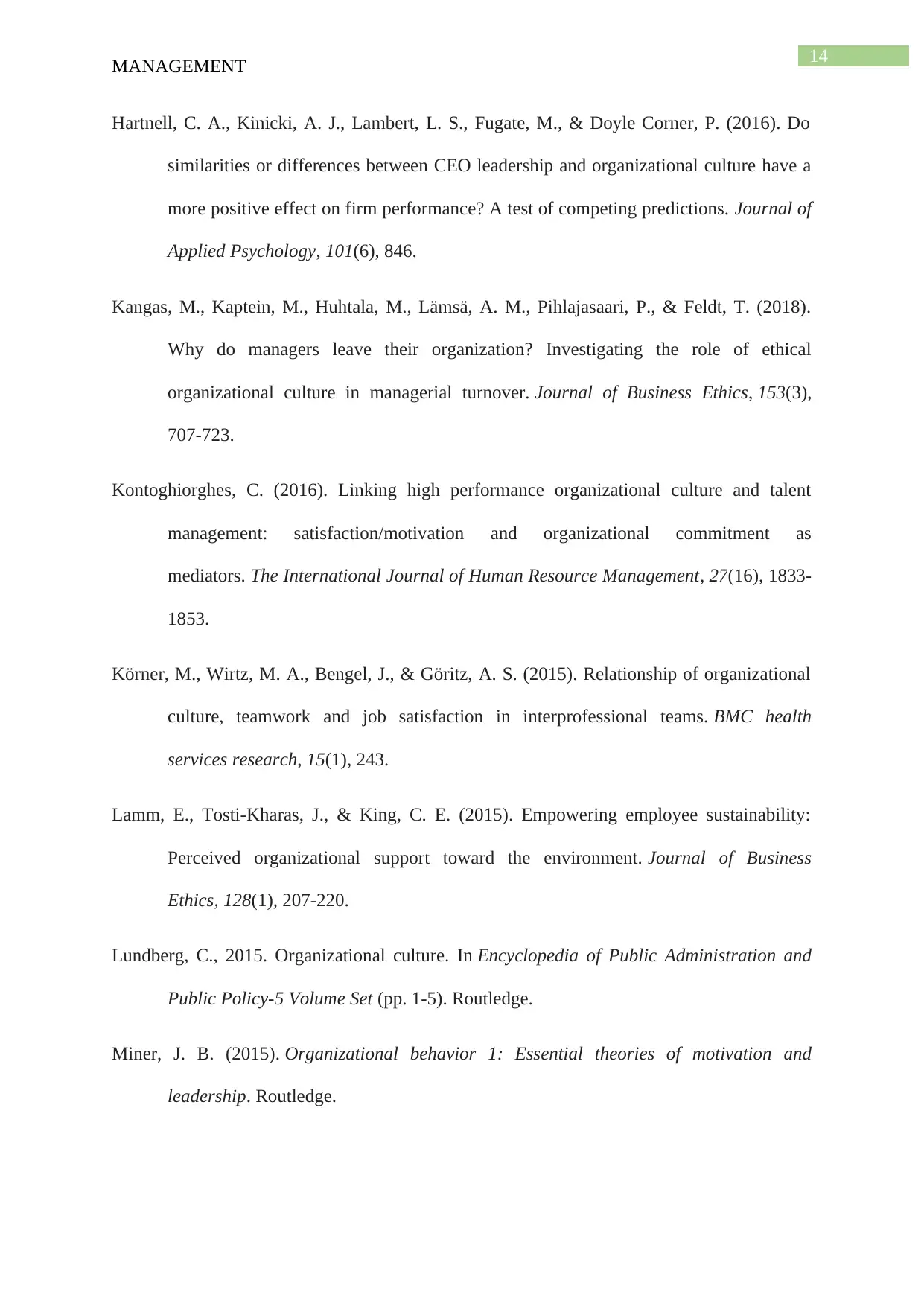
14
MANAGEMENT
Hartnell, C. A., Kinicki, A. J., Lambert, L. S., Fugate, M., & Doyle Corner, P. (2016). Do
similarities or differences between CEO leadership and organizational culture have a
more positive effect on firm performance? A test of competing predictions. Journal of
Applied Psychology, 101(6), 846.
Kangas, M., Kaptein, M., Huhtala, M., Lämsä, A. M., Pihlajasaari, P., & Feldt, T. (2018).
Why do managers leave their organization? Investigating the role of ethical
organizational culture in managerial turnover. Journal of Business Ethics, 153(3),
707-723.
Kontoghiorghes, C. (2016). Linking high performance organizational culture and talent
management: satisfaction/motivation and organizational commitment as
mediators. The International Journal of Human Resource Management, 27(16), 1833-
1853.
Körner, M., Wirtz, M. A., Bengel, J., & Göritz, A. S. (2015). Relationship of organizational
culture, teamwork and job satisfaction in interprofessional teams. BMC health
services research, 15(1), 243.
Lamm, E., Tosti-Kharas, J., & King, C. E. (2015). Empowering employee sustainability:
Perceived organizational support toward the environment. Journal of Business
Ethics, 128(1), 207-220.
Lundberg, C., 2015. Organizational culture. In Encyclopedia of Public Administration and
Public Policy-5 Volume Set (pp. 1-5). Routledge.
Miner, J. B. (2015). Organizational behavior 1: Essential theories of motivation and
leadership. Routledge.
MANAGEMENT
Hartnell, C. A., Kinicki, A. J., Lambert, L. S., Fugate, M., & Doyle Corner, P. (2016). Do
similarities or differences between CEO leadership and organizational culture have a
more positive effect on firm performance? A test of competing predictions. Journal of
Applied Psychology, 101(6), 846.
Kangas, M., Kaptein, M., Huhtala, M., Lämsä, A. M., Pihlajasaari, P., & Feldt, T. (2018).
Why do managers leave their organization? Investigating the role of ethical
organizational culture in managerial turnover. Journal of Business Ethics, 153(3),
707-723.
Kontoghiorghes, C. (2016). Linking high performance organizational culture and talent
management: satisfaction/motivation and organizational commitment as
mediators. The International Journal of Human Resource Management, 27(16), 1833-
1853.
Körner, M., Wirtz, M. A., Bengel, J., & Göritz, A. S. (2015). Relationship of organizational
culture, teamwork and job satisfaction in interprofessional teams. BMC health
services research, 15(1), 243.
Lamm, E., Tosti-Kharas, J., & King, C. E. (2015). Empowering employee sustainability:
Perceived organizational support toward the environment. Journal of Business
Ethics, 128(1), 207-220.
Lundberg, C., 2015. Organizational culture. In Encyclopedia of Public Administration and
Public Policy-5 Volume Set (pp. 1-5). Routledge.
Miner, J. B. (2015). Organizational behavior 1: Essential theories of motivation and
leadership. Routledge.
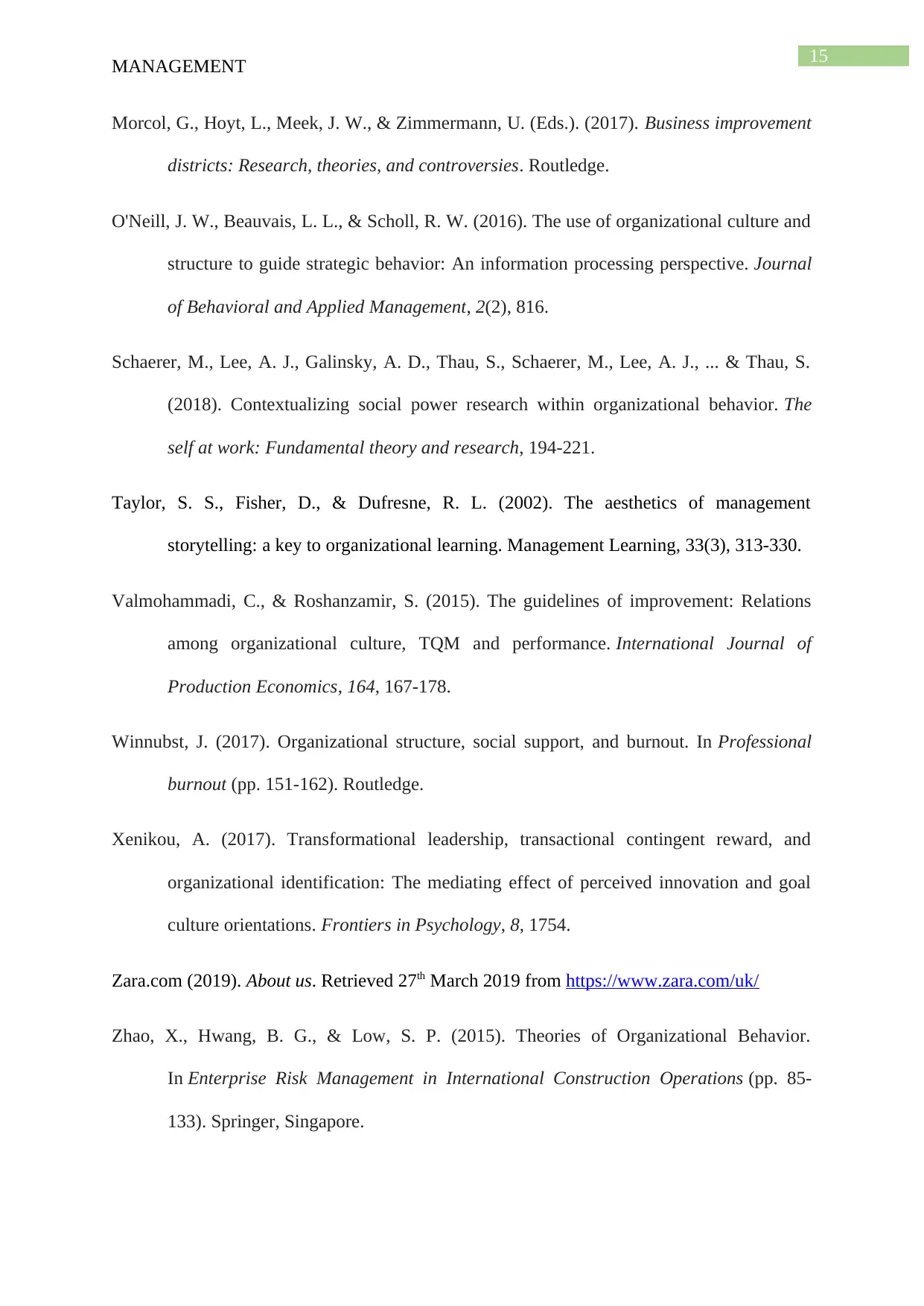
15
MANAGEMENT
Morcol, G., Hoyt, L., Meek, J. W., & Zimmermann, U. (Eds.). (2017). Business improvement
districts: Research, theories, and controversies. Routledge.
O'Neill, J. W., Beauvais, L. L., & Scholl, R. W. (2016). The use of organizational culture and
structure to guide strategic behavior: An information processing perspective. Journal
of Behavioral and Applied Management, 2(2), 816.
Schaerer, M., Lee, A. J., Galinsky, A. D., Thau, S., Schaerer, M., Lee, A. J., ... & Thau, S.
(2018). Contextualizing social power research within organizational behavior. The
self at work: Fundamental theory and research, 194-221.
Taylor, S. S., Fisher, D., & Dufresne, R. L. (2002). The aesthetics of management
storytelling: a key to organizational learning. Management Learning, 33(3), 313-330.
Valmohammadi, C., & Roshanzamir, S. (2015). The guidelines of improvement: Relations
among organizational culture, TQM and performance. International Journal of
Production Economics, 164, 167-178.
Winnubst, J. (2017). Organizational structure, social support, and burnout. In Professional
burnout (pp. 151-162). Routledge.
Xenikou, A. (2017). Transformational leadership, transactional contingent reward, and
organizational identification: The mediating effect of perceived innovation and goal
culture orientations. Frontiers in Psychology, 8, 1754.
Zara.com (2019). About us. Retrieved 27th March 2019 from https://www.zara.com/uk/
Zhao, X., Hwang, B. G., & Low, S. P. (2015). Theories of Organizational Behavior.
In Enterprise Risk Management in International Construction Operations (pp. 85-
133). Springer, Singapore.
MANAGEMENT
Morcol, G., Hoyt, L., Meek, J. W., & Zimmermann, U. (Eds.). (2017). Business improvement
districts: Research, theories, and controversies. Routledge.
O'Neill, J. W., Beauvais, L. L., & Scholl, R. W. (2016). The use of organizational culture and
structure to guide strategic behavior: An information processing perspective. Journal
of Behavioral and Applied Management, 2(2), 816.
Schaerer, M., Lee, A. J., Galinsky, A. D., Thau, S., Schaerer, M., Lee, A. J., ... & Thau, S.
(2018). Contextualizing social power research within organizational behavior. The
self at work: Fundamental theory and research, 194-221.
Taylor, S. S., Fisher, D., & Dufresne, R. L. (2002). The aesthetics of management
storytelling: a key to organizational learning. Management Learning, 33(3), 313-330.
Valmohammadi, C., & Roshanzamir, S. (2015). The guidelines of improvement: Relations
among organizational culture, TQM and performance. International Journal of
Production Economics, 164, 167-178.
Winnubst, J. (2017). Organizational structure, social support, and burnout. In Professional
burnout (pp. 151-162). Routledge.
Xenikou, A. (2017). Transformational leadership, transactional contingent reward, and
organizational identification: The mediating effect of perceived innovation and goal
culture orientations. Frontiers in Psychology, 8, 1754.
Zara.com (2019). About us. Retrieved 27th March 2019 from https://www.zara.com/uk/
Zhao, X., Hwang, B. G., & Low, S. P. (2015). Theories of Organizational Behavior.
In Enterprise Risk Management in International Construction Operations (pp. 85-
133). Springer, Singapore.
1 out of 16
Related Documents
Your All-in-One AI-Powered Toolkit for Academic Success.
+13062052269
info@desklib.com
Available 24*7 on WhatsApp / Email
![[object Object]](/_next/static/media/star-bottom.7253800d.svg)
Unlock your academic potential
© 2024 | Zucol Services PVT LTD | All rights reserved.




